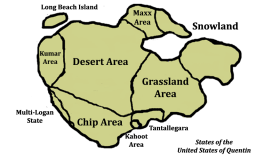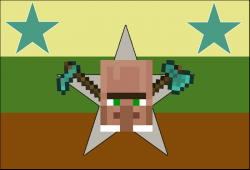Difference between revisions of "States of the United States of Quentin"
Maximumjedi (talk | contribs) |
Maximumjedi (talk | contribs) (→States of the United States of Quentin) |
||
| Line 34: | Line 34: | ||
| [[Grassland Area]] || 1834 || [[File:Flag of the Grassland Area.png|100px|center]] | | [[Grassland Area]] || 1834 || [[File:Flag of the Grassland Area.png|100px|center]] | ||
|- | |- | ||
| − | | [[Kahoot Area]] || 1865 || [[File: | + | | [[Kahoot Area]] || 1865 || [[File:It's the kahoot.png|100px|center]] |
|- | |- | ||
| − | | [[Kumar Area]] || 1883 || [[File:Flag of the Kumar | + | | [[Kumar Area]] || 1883 || [[File:Flag of the Kumar.png|100px|center]] |
|- | |- | ||
| [[Long Beach Island]] || 1895 || [[File:Flag of Long Beach Island.png|100px|center]] | | [[Long Beach Island]] || 1895 || [[File:Flag of Long Beach Island.png|100px|center]] | ||
Revision as of 17:23, 4 July 2020
| Quentinian States | ||
|---|---|---|
| ||
| Category | Federated States | |
| Location | United States of Quentin | |
| Number | 10 | |
| Populations | Largest: Chip Area, 255 million Smallest: Kahoot Area, 9 million | |
| Areas | Largest: Desert Area, 3,938,997km2 Smallest: Kahoot Area, 126,214km2 | |
| Governments | State Governments | |
| Further Subdivisions | State Districts | |
See also: Territories of the United States of Quentin
States of the United States of Quentin are constituent political entities which exist inside of the United States of Quentin, of which there are currently 10. Bound together in political union under the United States of Quentin Constitution, the states each hold governmental jurisdiction over their territories, and there is a sense of shared sovereignty between the states and the federal government, as citizens are citizens of both the USQ and the state in which they reside. State citizenship is flexible, and all states operate under the same federal law, including the fact that all citizens are free to travel anywhere in the nation.
These states are further divided into state districts, which are further subdivisions which make laws, although they operate with much less sovereignty than do states. Each state government operates with directions from its own state constitution, and although each government operates differently, all are grounded in republican principles of balance of power and are based off the model of the federal government.
States are differentiated from Quentinian territories by the fact that all states can devise their own state laws in addition to federal laws, each state has representatives in the House of Bureaucrats, Quentinian House of Representatives, and Presidential Electoral Committee, and has sovereignty, which the territories do not. Unlike other existing federations, the state concept of the USQ is dominated by the idea that the federal government is ultimately supreme, that states only exist for organizational and diversity reasons, and that states only exist as part of the federal government, meaning the federal government can dissolve any at any time, or create any at any time at its discretion. The Department of State, an executive federal department, was created for the sole purpose of enforcing the federal government's superiority over states, and for resolving issues between states.
States generally take care of such matters as education, public health, law enforcement, and transportation, and while the federal government operates programs on all of these subjects, they are on a much broader scale. The number of states has grown from the original four in 1834 to 10, with the last state, Long Beach Island, admitted in 1895. Debate has grown in the USQ over whether the territories of Berlinsavis and/or the Kade Islands should become states, to the point where it has become a major political issue in the country today.
Contents
States of the United States of Quentin
Below is a list of the 10 current states of the United States of Quentin, in alphabetical order, with their state flag and dates admitted as states.
State Date Admitted to Nation State Flag Chip Area 1872 Desert Area 1834 Grassland Area 1834 Kahoot Area 1865 Kumar Area 1883 Long Beach Island 1895 Maxx Area 1834 Multi-Logan State 1867 Snowland 1834 Tantallegara 1845
History
Independence and Constitution
Addition of States
Governments
Relationships
Between States
With the Federal Government
Possibilities of New States
Main article: Political Issues in the United States of Quentin § Addition of New States
There has been increased discussion about the possibility of new states joining the USQ, especially in the territories of Berlinsavis and/or the Kade Islands, so much so that it has become a major political issue in the nation.
Berlinsavis
Berlinsavis is currently a territory in the USQ, and is the second-most populated territory. The territory has high strategic and economic value to the nation, however, as its proximity to the Zwakazi continent and the Nista Federation of States and its economic output is the highest by far. In the Berlinsavis Statehood Referendum of 2009, the territory voted 65% to remain as a territory, and in the 2015 referendum, the territory voted by 67% to remain a territory, with about 50% voter turnout in each. The upcoming 2021 referendum is expected to decide the outcome of the vote, and turnout is expected to be much higher than the two previous. Main opposition to the statehood has been people of Zwakanav ethnicity, as many see belonging to the USQ as an extension of imperialism and not compatible with their identity. Proponents believe statehood would bring much needed education, infrastructure, healthcare, and democracy to the territory, which is ranked among the most corrupt subdivisions in the USQ.
Kade Islands
The Kade Islands is currently a territory as well, and has the most people out of any territory in the nation. It has low economic value, but high strategic and government value, as the nation has numerous military bases and government infrastructure there. The referendums of 2002, 2008, and 2014 all turned positive results, with an average 68% voter turnout and an average 84% in favor of statehood. The upcoming 2020 referendum is expected to be the deciding factor, as the Kad'dgen Territorial Assembly voted to pass the 2020 Kade Islands Statehood Bill if the referendum turned up in favor of statehood. The bill would formally petition the nation's federal government to become a state.
The Kade Islands have the highest percentage of Quentinian-descended citizens of all the territories in the USQ, meaning natives of the island and descendants of immigrants from other nations are low. The territorial government there has made numerous concessions on military and government installations to the federal government in the past, and the territory's anthem is Liberty in the Noise. Opponents of statehood say that it would threaten the culture of the island, and would threaten the island's policies of natural preservation.
State Name Origins
See also: List of Quentinian State Name Origins
The 10 states of the United States of Quentin have their own names, which were chosen by either a referendum, by the state's government, or by the federal government upon the date of admission to the nation as states. In many cases, the names of states are also the names of the territories which preceded these states, such as the Grassland Territory and the Grassland Area, however that is not always the case. Below is a list of the state name origins of all 10 states:
|
|












